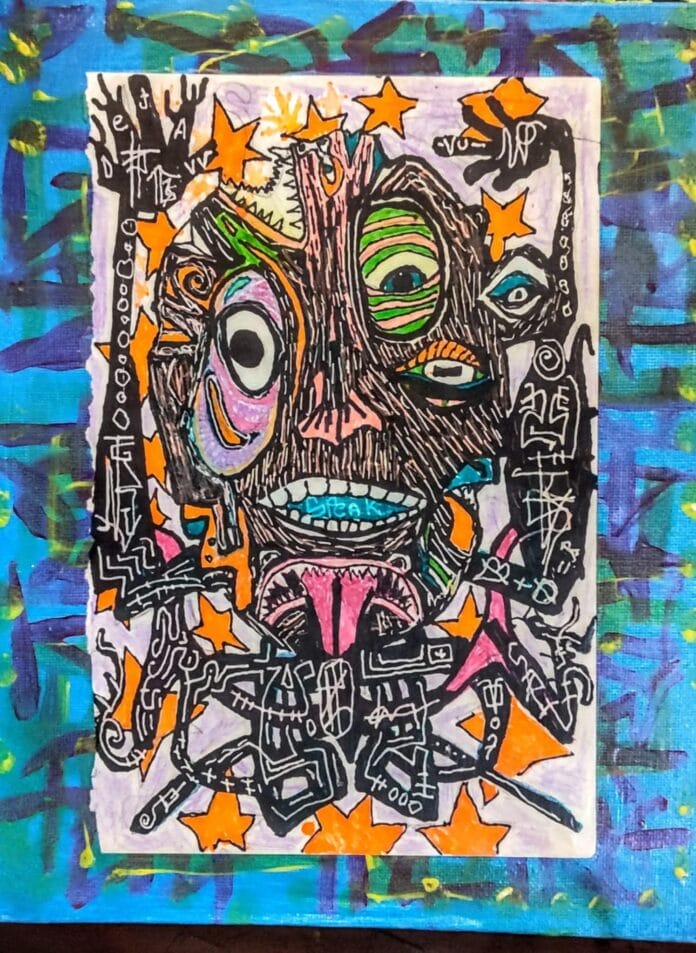Charles Milles was born in Hawaii in 1983 and moved to Washington State at the age of two. Carrying the vibrant natural and cultural heritage of Hawaii within him, he grew up surrounded by the lush forests and shifting skies of the Pacific Northwest. From an early age, he felt a deep connection to the unseen, often sensing an eerie presence in shadows, in the fireplace, or even behind his own eyes.
Cryptids, folklore, and legends of all kinds became a constant presence in his thoughts. He has always imagined that everyone perceives the world differently, like one person’s red might be another’s neon purple. As a child, he would daydream about stepping into the minds of others to experience their realities.
His life has been marked by a vivid contrast of influences. His father was a dark cloud over his youth, while his mother shone as a great diamond in the sky. This interplay of shadow and light would later find its way into his art, shaping both its emotional depth and spiritual undertones. Charles describes himself as overemotional, a quality he often struggles with but also recognizes as a source of his creative vision.
A Vision of a Living Petroglyph
In his latest artwork, Charles explores the concept of a petroglyph or magical sigil brought to life. He envisions what it would look like if such a creation, designed for healing and protection, were given the spark of life. The piece asks what it would mean for such a being to exist, not just as a symbol but as a sentient creature capable of thought and feeling.
Would it appreciate the gift of a body, or would it resent the reasoning behind its creation? Could it reproduce, or even have the desire to do so? Would it live in joy or pain? These questions form the emotional and philosophical foundation of the work.
Inside the drawing, many of Charles’s own sigils are integrated, merging into the overall form. The result is a petroglyph that appears to have stepped out of the stone and into the living world. It is both ancient and alive, a fusion of past and present, of human intention and independent existence.
Art as a Metaphysical Dialogue
For Charles, the work is more than a drawing. It is a dialogue between creator and creation, a meditation on the human tendency to design symbols as shields against the unknown. Across cultures, people have crafted sigils and talismans as a way to influence or protect their lives. Charles’s artwork invites the viewer to question this relationship.
If these protectors could speak back to us, what would they say? Would they be loyal guardians or reluctant captives? In this sense, the artwork functions as a mirror, reflecting the intentions and fears of its maker while also hinting at the independent will of what has been made.
The Influence of Shadows and Light
The duality of his upbringing has had a strong influence on Charles’s artistic voice. The darkness of his father’s presence and the radiant positivity of his mother created a balance of tension and hope in his worldview. This is reflected in his fascination with belief systems, metaphysical thought, and the search for truth.
In his work, beauty often coexists with unease. Protective symbols may also carry an undercurrent of vulnerability. For Charles, this is part of the human experience: the things we create to shield ourselves may one day develop identities and purposes of their own.
A Quest for Truth
Charles’s artistic journey is deeply tied to his search for meaning in belief and metaphysics. He has long been drawn to the mystery of symbols, not only for their aesthetic power but for their spiritual weight. A petroglyph, in his view, is more than an artifact of the past. It is a vessel for meaning, a point of connection between the physical and the unseen.
His latest work becomes a thought experiment in visual form. It challenges the viewer to consider the implications of granting life to a symbol. Does this bridge the gap between imagination and reality, or does it create something entirely new and unpredictable?
The Voice of the Petroglyph
The living petroglyph in Charles’s piece does not offer easy answers. Instead, it invites the viewer to imagine its voice. Perhaps it would speak in gratitude for the chance to live, perhaps in confusion about its purpose, or perhaps in defiance of the role assigned to it.
In this way, the artwork is as much about the audience’s response as it is about the artist’s intent. Each viewer brings their own beliefs, fears, and questions, completing the dialogue, the work begins.
Conclusion: Between Creator and Creation
Charles Milles’s art bridges ancient tradition and modern imagination. It is rooted in personal history, shaped by contrasting forces of shadow and light, and fueled by a lifelong curiosity about the unseen.
His living petroglyph is not only a representation of mystical protection but also a commentary on the nature of creation itself. It asks us to consider the life of the things we bring into the world and whether, if they could speak, they would bless us, curse us, or simply ask to be free.


